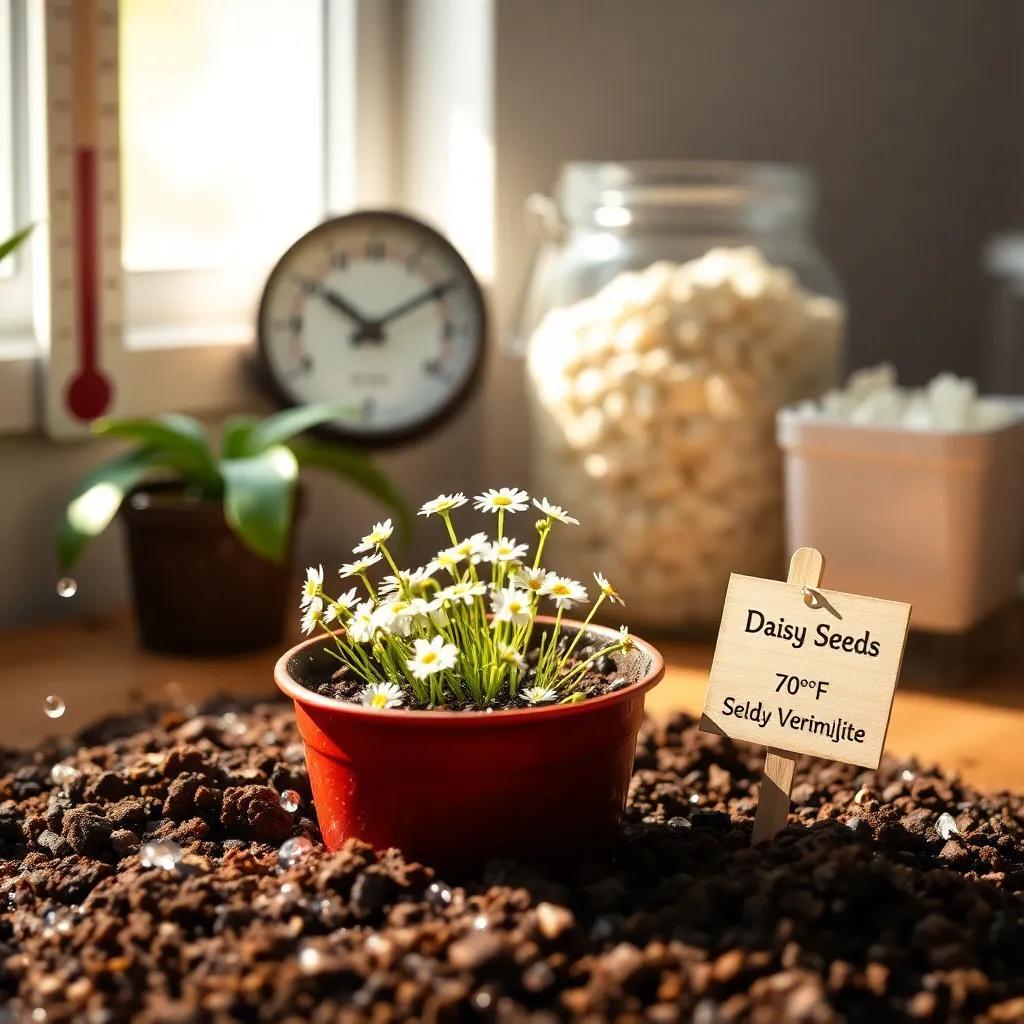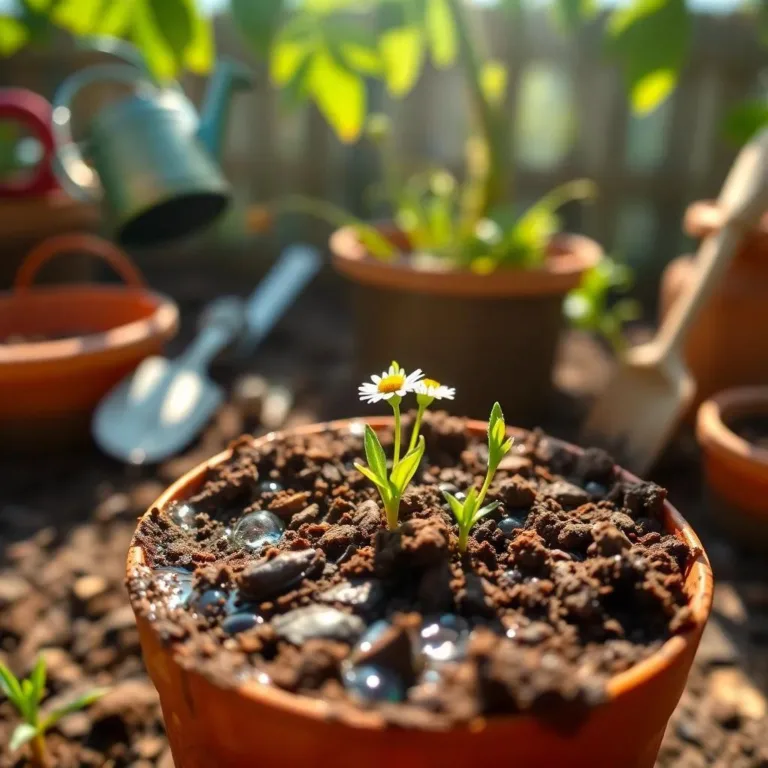Are you ready to watch magic unfold in your garden? Growing daisies from seeds is not only fun, but it’s also a delightful way to bring bursts of color to your outdoor space! Join me as we explore the secrets to successful germination, the perfect growing conditions, and how to tackle any challenges that may come your way. Let’s dig in and get those daisies blooming! 🌼
Germination Process for Daisy Seeds
Germinating daisy seeds is an exciting adventure! Just like waiting for cookies to bake, it takes a little patience and the right conditions. To start the germination process, I like to set the stage for these tiny seeds to do their magic.
First, gather your supplies. You’ll need a well-draining seed-starting mix or a blend of peat moss and vermiculite. These ingredients create a cozy home for the seeds. Fill a small pot or seed tray with this mix and lightly moisten it. But hold on! We don’t want a soggy mess—just a gentle mist will do!
Now, it’s time to plant the seeds. Scatter the daisy seeds evenly over the surface of the growing medium. Remember, these seeds are tiny! Just cover them with a thin layer of soil. I like to lightly pat the soil to make sure the seeds have good contact but not too deep!
Next, find a warm spot with some indirect sunlight. Daisies love warmth, and the ideal temperature is around 65-75°F (18-24°C). Think of it like a nice spa day for your seeds! To help maintain moisture, mist the soil often but avoid flooding it. You can even cover the pot with a clear plastic dome or a plastic bag to keep that humidity up!
With a little luck, those seeds will start sprouting in just 10-14 days! Wow, right? But be patient; different daisy varieties may take a bit longer. Once you see those little green shoots, remove the cover so the seedlings can breathe! Keeping a close eye on your seeds and providing them with water and light helps them thrive!
Factors Influencing Daisy Seed Germination
Now that we’re on this beautiful journey of growing daisies, let’s chat about what affects how fast those seeds sprout, shall we? Here are some key factors to keep in mind:
- Temperature: As I mentioned before, daisy seeds love warmth! Keeping them in that sweet spot of 65-75°F (18-24°C) is a game-changer. Too hot or too cold? Well, let’s just say it’s like trying to bake cookies in a snowstorm—nothing good will come of it!
- Moisture: Think of moisture as the lifeblood for germination. The soil should feel like a damp sponge—not a swimming pool! Too dry? The seeds might just take a nap and never wake up. Too wet? They could drown. Aim for just the right balance!
- Light: Daisies need a little light to get started. When planting those tiny seeds, make sure they’re only lightly covered. Place them in a bright spot or use grow lights to give them the kick they need to germinate. They’re like little sunbathers soaking up those rays!
- Seed Quality: Oh boy, make sure you’re using fresh seeds! Old or poor-quality seeds can be like a cake recipe that calls for expired flour—yikes! Look for seeds from reputable sources for the best results.
- Seed Treatment: Some seeds are a bit stubborn with their hard outer coats. If you’re feeling adventurous, techniques like scarification (nicking the seeds) or stratification (cold treatment) can help them sprout faster!
With these factors in mind, you’ll be well on your way to a blooming garden! Happy planting! 🌼

Ideal Conditions for Growing Daisies
Growing daisies is such a delight, and setting the right conditions is key to their success! These cheerful flowers thrive in specific environments, so let’s talk about how to create the perfect home for them!
- Sunlight: Daisies absolutely love the sun! Ideally, they need 6-8 hours of direct sunlight each day. Find a sunny spot in your garden or on your balcony where these beauties can soak up those rays. Trust me, they’ll reward you with vibrant blooms if you do!
- Soil: The right soil makes all the difference! Daisies prefer well-draining soil with a pH of around 5.8 to 7.0. If your soil is heavy and clay-like, mix in some compost or aged manure to help it drain better. Daisies like to stretch their roots, so loose soil is a happy place for them!
- Watering: While daisies are pretty resilient, they still appreciate a good drink. They thrive on evenly moist soil but not soggy conditions. When watering, aim for deep watering sessions, letting the water soak in well. And hey, adding mulch around the plants can help keep moisture in while keeping pesky weeds at bay!
- Temperature: Daisies flourish in cooler temperatures, typically between 60-75°F (15-24°C). They can handle a light frost, but we want to avoid letting them freeze for too long. If summers get too hot, providing some afternoon shade can save them from wilting!
- Air Circulation: Good airflow is like a breath of fresh air for daisies! Plant them with enough space in between to let air move freely. This can help keep diseases at bay, giving your daisies a better chance to thrive.
By creating these ideal conditions, you’re offering your daisies the chance to grow strong and healthy. Now, let’s move on to the exciting part—the timeline for their growth!
Timeline for Daisy Seedling Development
Once those daisy seeds have germinated, the real fun begins! Watching them grow is like seeing magic happen right before your eyes. Here’s what to expect in the timeline of daisy seedling development:
- Seedling Stage (Weeks 1-2): After germination, you’ll see tiny seedlings sprouting! It’s like nature is sending you little green thumbs up. During this stage, the seedlings develop their first true leaves. They’ll look delicate, but don’t be fooled—these babies are just getting started!
- Vegetative Growth (Weeks 3-8): This stage lasts about 4-6 weeks. The seedlings will grow bigger and stronger, putting energy into developing lush, green foliage. The stem will stretch, and the leaves will flourish. Think of it as their “teenage years”—they’re growing up fast and building a solid foundation!
- Buds and Flower Development (Weeks 9-12): As the days go by, the seedlings will begin to prepare for their big moment. In the second or third month, they’ll form cute little flower buds. Depending on the daisy variety and conditions, this stage might take a little longer. Patience is key here, my friend!
- Flowering Stage (Weeks 12+): Finally, the day arrives when the flower buds burst open into beautiful blooms! This is the stage we’ve all been waiting for! Daisies will present their lovely petals around a central disk. The exact blooming time varies by species, but it’s typically a vibrant display that can last for several weeks or even months.
- Seed Production (Post-Blooming): After the flowers fade, the daisy plants will produce seeds. You might see the petals drop off while seed heads form. This allows your daisies to spread their joy by creating new plants for next year!
Tracking these stages helps me keep an eye on my daisies and their needs. With each passing week, there’s always something wonderful happening in the garden!
Common Challenges When Growing Daisies from Seeds
While growing daisies can be a joyful experience, there are a few challenges that might pop up along the way! Don’t worry, though—I’ve got tips to help you tackle these common issues!
- Low Germination Rates: Sometimes, not all seeds will sprout. This can happen due to poor seed quality or less-than-ideal conditions. To boost your chances, use fresh seeds and maintain the right temperature and moisture. Fresh ingredients always make for the best recipes, right?
- Damping Off: This is a sneaky fungal disease that can affect seedlings, causing them to wilt and die. To keep damping off at bay, ensure good air circulation and avoid overwatering. If it strikes, remove the affected seedlings and adjust your watering habits to save the rest!
- Competition from Weeds: Weeds are like uninvited guests at a party—they take up space and resources. Keep your planting area weed-free by regularly checking for these pesky intruders. Mulching can help suppress their growth and give your daisies more room to thrive.
- Pests and Diseases: Daisies can attract pests like aphids or slugs, which can be a bit of a nuisance. Monitor your plants regularly and take action if you spot any troublemakers. Organic pest control methods or even handpicking them can work wonders!
- Transplanting Shock: When moving seedlings outdoors, they might feel stressed. To prevent shock, I recommend hardening them off first. Gradually introduce them to outdoor conditions by letting them enjoy fresh air for a few hours each day. This helps them adapt to their new home without feeling overwhelmed.
- Insufficient Light: Daisies need sunlight to thrive, and if they don’t get enough, they might grow weak and leggy. Ensure they receive 6-8 hours of sunlight each day! If they’re not getting their fill, consider moving them to a brighter spot or supplementing with grow lights.
By keeping an eye out for these common challenges, I feel more prepared to nurture my daisies and watch them bloom beautifully. After all, a little care goes a long way in creating a vibrant garden! 🌼

